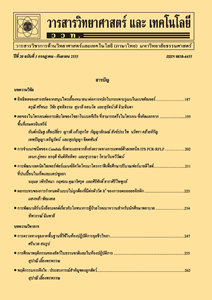การเปรียบเทียบประสิทธิภาพสำหรับวิธีการเปรียบเทียบพหุคูณแบบอิงพารามิเตอร์และไม่อิงพารามิเตอร์ของแผนแบบการทดลองสุ่มในบล็อกไม่สมบูรณ์
Main Article Content
Abstract
The objective of this research was to multi-compare the control efficiency of probability of type I error and power of a test between parametric and nonparametric tests of a randomized incomplete block designs. The 6 statistics were Duncan’s new multiple range, Waller-Duncan and Fisher’s least significant difference, Conover, Durbin and Skillings-Mack. In all cases, we used randomized data with a normal distribution, gamma distribution and beta distribution for calculating the probability of type I error and the power of a test. Creating a randomized incomplete block designs will determine the number of treatments (that equal to 3, 4, 5, 6 and 7 treatments), and the number of blocks (that equal to 3, 4, 5, 6 and 7 blocks). Two significance levels were used 0.05 and 0.10. The results for probability of type I error revealed that, for controlling probability of type I error, the Waller-Duncan and Fisher’s least significant difference were the best in controlling it. For the power of a test, the Waller-Duncan showed the highest power of a test.
Article Details
References
Updisakun, S., 1994, Experimental Designs 2, 2nd Ed., Sahamit Offset, Bangkok. (in Thai)
Kongnapasantikul, T., Taengthong, T., Nopas, T. and Pattisai, N., 2006, Comparisons of Probability of Type I Error and the Power of a Test Between Parametric and Nonparametric Tests in Multiple Comparisons of a Randomized Complete Block Design, Bachelor Project, King Mongkut’s Institute of Technology Ladkrabang, Bangkok. (in Thai)
Pinchoo, P., 2007, Comparisons of type I error rates and power of the test in post hoc comparison procedures for completely randomized design, J. Res. Meth. 20(3): 331-351. (in Thai)
Ozkaya, G. and Ercan, I., 2012, Examining multiple comparison procedures according to error rate, power type and false discovery rate, J. Mod. Appl. Stat. Methods. 11: 348-360.
Kemp, K.E., 1973, Multiple comparisons: Comparisonwise versus experimentwise type I error rates and their relationship to power, J. Dairy Sci. 58: 1374-1377.
Li, Y., 1997, The Development of Power Estimates and Sample Size Requirements for Seven Multiple Comparisons Procedures, Doctoral Dissertation, University of Maryland, Baltimore.
Srisa-ard, B., 1995, Statistical Methods for Research, Department of Educational Administration, Faculty of Education, Srinakharinwirot University, Bangkok. (in Thai)
Francisco, D.A.S.S. and Carlos, A.V.D.A., 2016, Comparison of means of agricultural experimentation data through different tests using the software Assistat, Afr. J. Agric. Res. 11: 3527-3531.
Armando, C., Décio, B. and Clarice, G.B.D., 2008, Modifications for the Tukey test procedure and evaluation of the power and efficiency of multiple comparison procedures, Sci. Agric. 65: 428-432.
Khumsaard, N., 2009, Power of Test on Multiple Comparison, Master Thesis, Srinakharinwirot University, Bangkok. (in Thai)
Anthony, J.H., 2012, The maximum familywise error rate of Fisher's least significant difference test, J. Am. Stat. Assoc. 396: 1000-1004.
David, J.S., 2012, Multiple comparison procedures-cutting the Gordian knot, Agron. J. 107: 730-735.
Douglas, C.E., Multiple Comparisons: Philosophies and Illustrations, Available Source: www.physiology.org/journal/ajpregu, April 19, 2019.
Ongchirawod, V., 1979, The Comparison of Various Methods for Testing the Difference between Population Means by Considering Three Type of Error, Master Thesis, Chulalongkorn University, Bangkok. (in Thai)
Carmer, S.G. and Walker, W.M., 1985, Pairwise multiple comparisons of treatment means in agronomic research, J. Agron. Educ. 14: 19-26.
Bradley, J.V., 1978, Robustness, Br. J. Math. Stat. Psychol. 31: 144-152.


